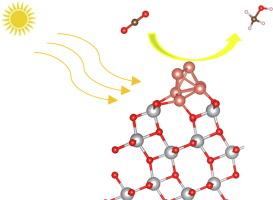Revolutionizing CO2 conversion for single-carbon products: Unveiling the photocatalytic magic of M6@TiO2 via First-Principles insights
IF 6.3
2区 材料科学
Q2 CHEMISTRY, PHYSICAL
引用次数: 0
Abstract
Metal clusters can be loaded as cocatalysts on the surface of TiO2 to promote the photocatalytic reduction of CO2. However, the specific mechanism of this reaction is still unclear. This study systematically investigates the performance of metal cluster (M6, M = Au, Ag, Mn, Cu, Sn, Ga, Mo and Bi) as the cocatalytic on the TiO2(101) surface towards the CO2 reduction reaction through density functional theory (DFT) calculations. Metal clusters as co-catalysts supported on TiO2 can improve the light absorption intensity of photocatalysts. Moreover, it was found that these metal clusters significantly improved the electron transport efficiency of TiO2, thereby enhancing the efficiency of photocatalytic CO2 reduction. Cu6@TiO2 showed the highest photocatalytic activity, with a maximum Gibbs free energy change (ΔGmax) of 0.46 eV. The study also revealed a strong correlation between catalytic activity and the adsorption strength of key intermediates, indicating that enhancing the adsorption differences of key intermediates can improve the efficiency of photocatalysts. In addition, Mn6@TiO2, Cu6@TiO2, Mo6@TiO2, Au6@TiO2, and Ga6@TiO2 can effectively suppress the hydrogen evolution reaction (HER), demonstrating excellent photocatalytic performance and high selectivity. This work provides useful insights into the reduction of CO2 to form single carbon products on TiO2 catalysts loading metal clusters.


革新单碳产品的二氧化碳转化:通过第一原理的见解揭示M6@TiO2的光催化魔力
金属团簇可以作为助催化剂负载在TiO2表面,促进CO2的光催化还原。然而,这种反应的具体机制尚不清楚。本研究通过密度泛函理论(DFT)计算,系统地考察了金属团簇(M6, M = Au, Ag, Mn, Cu, Sn, Ga, Mo和Bi)作为TiO2(101)表面CO2还原反应的共催化剂的性能。在TiO2上负载金属团簇作为共催化剂,可以提高光催化剂的光吸收强度。此外,研究发现这些金属团簇显著提高了TiO2的电子传递效率,从而提高了光催化CO2还原的效率。Cu6@TiO2的光催化活性最高,Gibbs自由能变化(ΔGmax)最大值为0.46 eV。研究还揭示了催化活性与关键中间体的吸附强度之间存在较强的相关性,表明提高关键中间体的吸附差异可以提高光催化剂的效率。此外,Mn6@TiO2、Cu6@TiO2、Mo6@TiO2、Au6@TiO2和Ga6@TiO2可以有效抑制析氢反应(HER),表现出优异的光催化性能和高选择性。这项工作为在负载金属簇的TiO2催化剂上减少二氧化碳形成单碳产物提供了有用的见解。
本文章由计算机程序翻译,如有差异,请以英文原文为准。
求助全文
约1分钟内获得全文
求助全文
来源期刊

Applied Surface Science
工程技术-材料科学:膜
CiteScore
12.50
自引率
7.50%
发文量
3393
审稿时长
67 days
期刊介绍:
Applied Surface Science covers topics contributing to a better understanding of surfaces, interfaces, nanostructures and their applications. The journal is concerned with scientific research on the atomic and molecular level of material properties determined with specific surface analytical techniques and/or computational methods, as well as the processing of such structures.
 求助内容:
求助内容: 应助结果提醒方式:
应助结果提醒方式:


